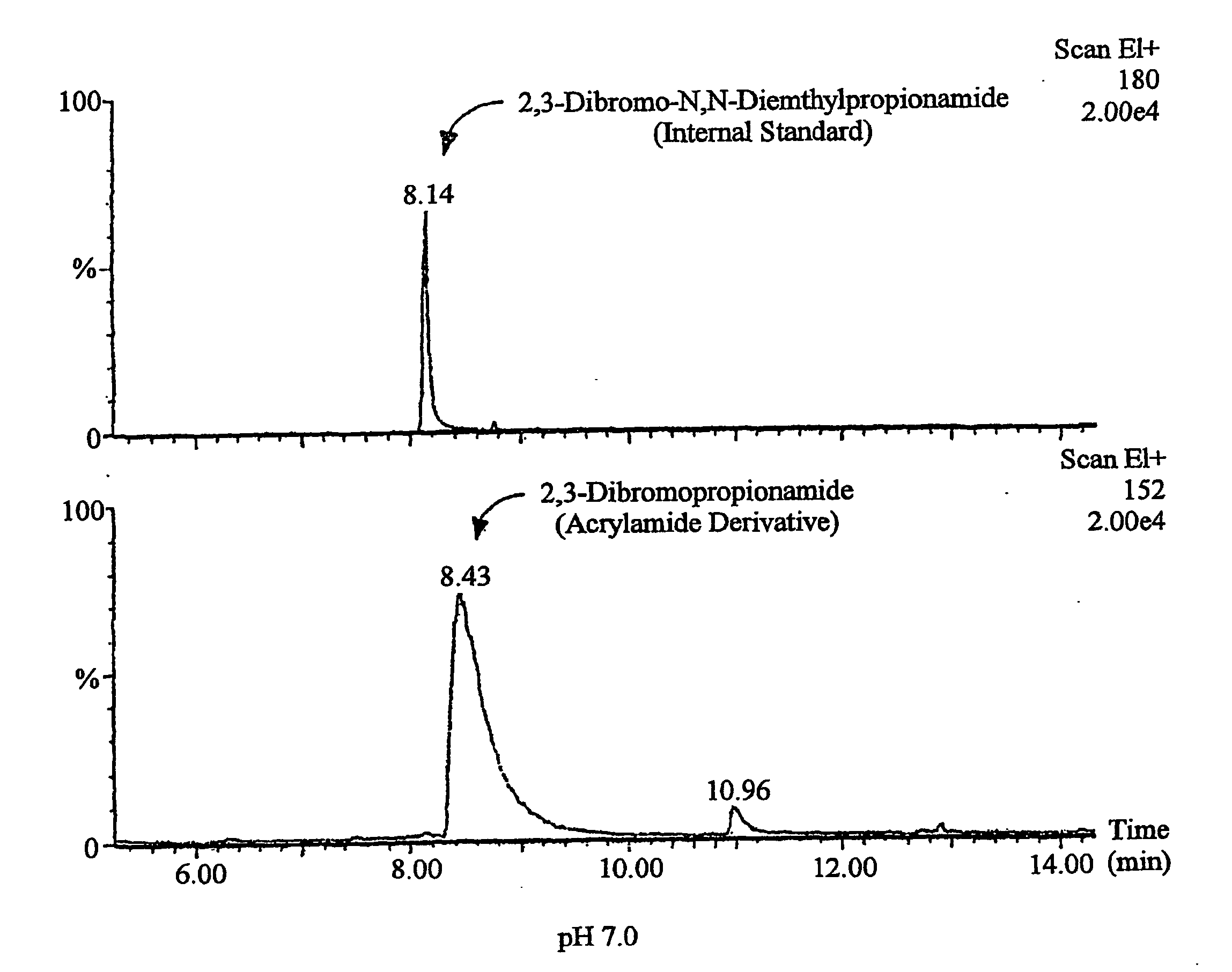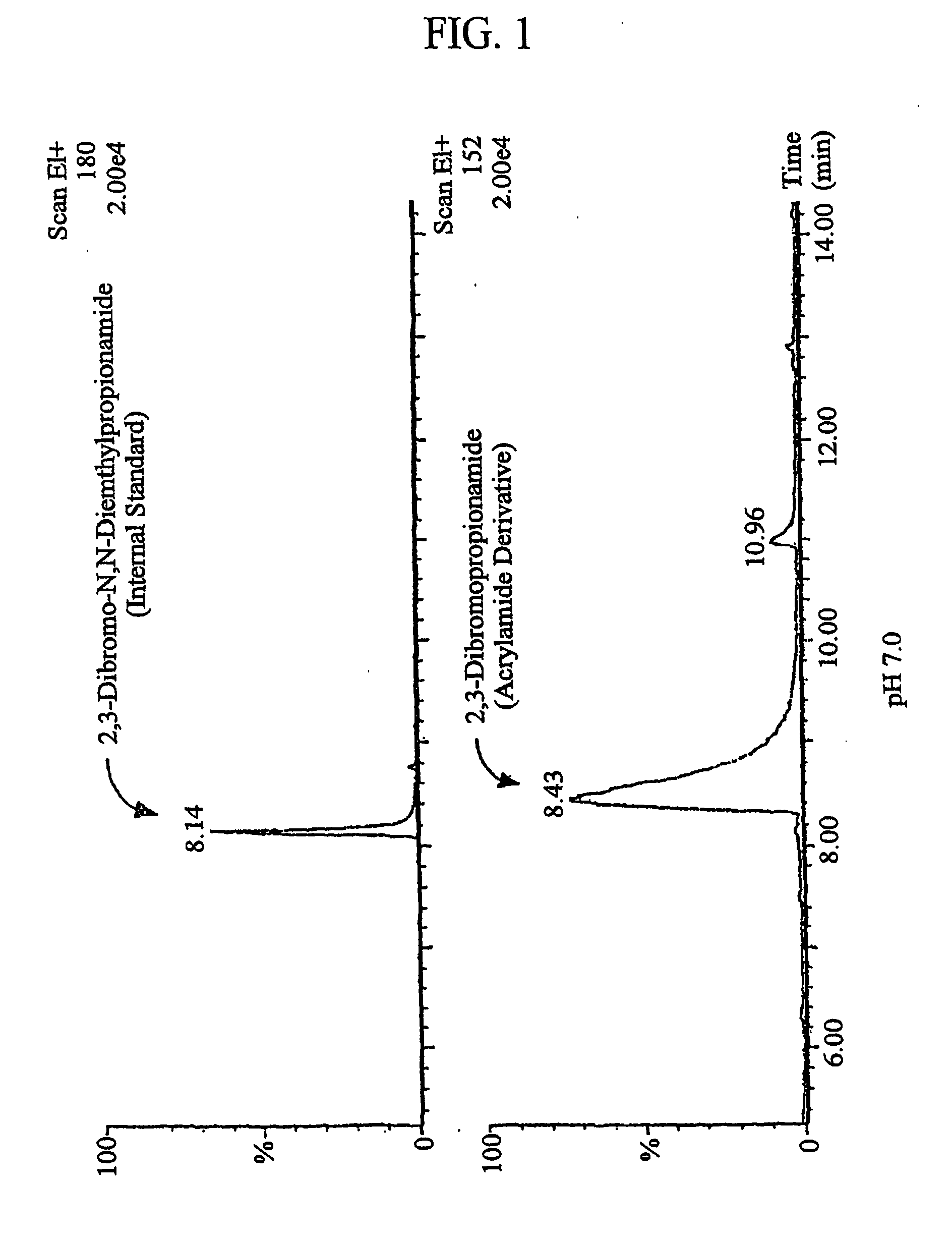Method for the reduction of acrylamide formation
- Summary
- Abstract
- Description
- Claims
- Application Information
AI Technical Summary
Benefits of technology
Problems solved by technology
Method used
Image
Examples
example 1
Effect of Reduction of Acrylamide Formation in Fried-Corn Chips According to Addition of pH-Lowering Agent
[0029] 500 ml of each of 0.1% or 0.2% citric acid solutions was added to 500 g of corn grits (coarsely ground to a size smaller than 1 mm), and the mixture was steamed at 121° C. for 60 minutes. The 0.1% and 0.2% citric acid solution treatment is equivalent to 0.1% and 0.2% citric acid addition to corn grits, respectively. Meanwhile, a control group was added with 500 ml of distilled water as substitute for the citric acid solution. The mixture was measured for its pH with a pH meter, cooled and passed several times through rolling rollers to produce thin sheet of corn grit doughs having a thickness of 1 mm. The thin corn sheets were cut to a size of 2×2 cm, and dried at room temperature to make a corn chip bases. The dried corn chip bases were fried with corn oil at 180° C. for 30 seconds to produce fried-corn chips.
[0030] 10 g of each of the corn chip samples produced as des...
example 2
Sensory Evaluation of Flavor and Color of Fried-Corn Chips Produced with Addition of pH-Lowering Agent According to the Present Invention
[0037] The flavor and color of the fried corn chips produced with the addition of citric acid according to Example 1 were compared to the fried corn chips produced with the addition of distilled water.
[0038] The flavor of the corn chips was tested using 10 assessors by a discriminative test method where the difference between two samples be discriminated. The comparison in color between the test group and the control group was conducted by observation with the naked eye.
[0039] As a result, the flavor of the corn chips was not substantially changed by the addition of citric acid. However, the sample added with 0.2% citric acid solution showed a tendency to be slightly lighter in color. Therefore, it was found that the treatment of foods with the pH-lowering agent according to the present invention did not affect the flavor of foods.
example 3
Effect of Reduction of Acrylamide Formation in Baked Corn Chips According to Addition of pH-Lowering Agent
[0040] 500 ml of 0.1% or 0.2% citric acid solutions was added to 500 g of corn grits, and the mixture was steamed at 121° C. for 60 minutes. Meanwhile, a control group was added with 500 ml of distilled water as substitute for the citric acid solution. After cooling the mixture, thin sheets of corn grit doughs were produced and dried in the same manner as in Example 2 to produce corn chip bases. The corn chip bases were heated in an oven at 255° C. for 1 minute and 40 seconds to produce corn chips. Also, among the corn chip bases, the corn grits treated with the 0.2% citric acid solution were heated in an oven at 255° C. for 2 minutes to produce corn chips. The produced corn chips were purified and then the amount of acrylamide formed in the purified samples was analyzed in the same manner as in Example 1.
[0041] As a result, the amounts of formed acrylamide were 151 ppb in the...
PUM
 Login to View More
Login to View More Abstract
Description
Claims
Application Information
 Login to View More
Login to View More - R&D
- Intellectual Property
- Life Sciences
- Materials
- Tech Scout
- Unparalleled Data Quality
- Higher Quality Content
- 60% Fewer Hallucinations
Browse by: Latest US Patents, China's latest patents, Technical Efficacy Thesaurus, Application Domain, Technology Topic, Popular Technical Reports.
© 2025 PatSnap. All rights reserved.Legal|Privacy policy|Modern Slavery Act Transparency Statement|Sitemap|About US| Contact US: help@patsnap.com



